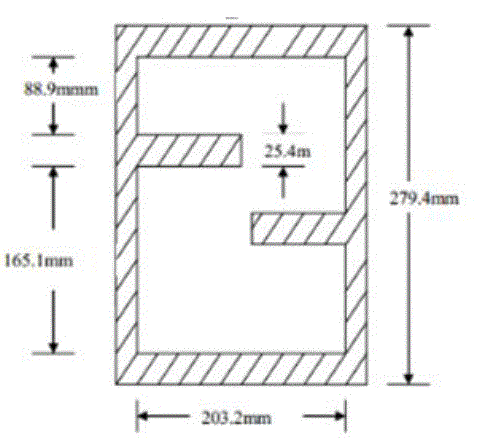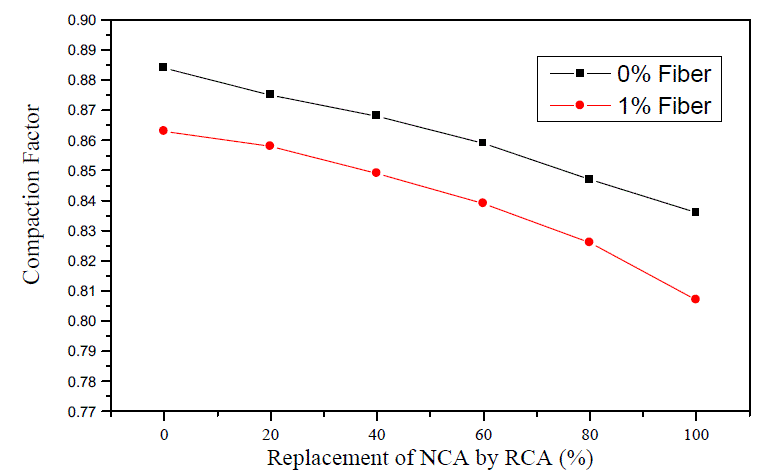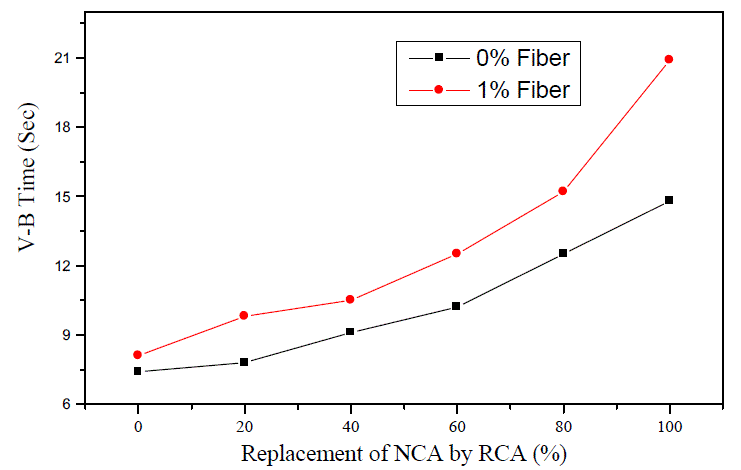ISSN ONLINE(2319-8753)PRINT(2347-6710)
ISSN ONLINE(2319-8753)PRINT(2347-6710)
|
Vaishali.G. Ghorpade1 Associate Professor & HOD, Department of Civil Engineering, JNTUA College of Engineering, Anantapur, India1 |
| Related article at Pubmed, Scholar Google |
Visit for more related articles at International Journal of Innovative Research in Science, Engineering and Technology
This paper is aimed at investigating the shear strength and work ability characteristics of Fiber Reinforced High Strength Concrete (FRHSC) which use recycled coarse aggregates that have originated from demolished construction wastes. Different mixes were taken with 0%, 20% , 40% , 60% , 80% and 100% replacement of natural coarse aggregate with recycled coarse aggregate.To improve the ductility and performance, 1% steel fiber is also added to the concrete. The shear strength of FRHSCmixes was obtained by casting and testing double –L (push-off) specimens after curing for 28 days. The effect of replacement of natural granite aggregate with recycled coarse aggregate on shear strength and workability of FRHSC has been evaluated at length in this paper
Keywords |
| Cement, Natural fine aggregate, Natural coarse aggregate, Recycled aggregate, Water, super plasticizer |
INTRODUCTION |
| Concrete is the premier construction material used widely across the world in all types of engineering works, including infrastructure, low and high-rise buildings, defense installations and local/ domestic developments. It plays an important role in shaping our environment and sustainability of construction industry. Efforts to improve the propertiesof concrete are continuously being made by researchers which led to the development of fiber reinforced concrete, ferro-cement concrete, slurry infiltrated fibrous concrete. Fiber Reinforced High Strength Concrete (FRHSC) can be effectively used in RCC members subjected to extreme loading conditions such as seismic loading, blast loading and impact loading. It is generally accepted that the presence of fibers improves the performance of concrete. The main function of the fibers is to resist the opening of cracks due to micro-cracking, increase the ability of the composite to withstand loads, and to allow larger strains in the neighborhood of fibers. Recycled aggregates are produced from the re-processing of waste materials, the largest source being Construction and Demolition (C&D) waste. According to Commonwealth Scientific & Industrial Research Organization (CSIRO), C & D waste makes up to around 40% of the total waste each year (estimated around 14 million tons) posing severe disposal problems. The reuse of this construction and demolition waste in the form of recycled aggregate concrete (RAC) is viewed as an effective attempt to conserve the natural resource s and preserving the environmental ecological balance. The research work carried out in the past on the use of recycled aggregates is mainly focused on issues related to the processing of C&D waste, mechanical properties, mix design and durability. In fact suitability of coarse recycled aggregates for use in normal grade concretes for a large range of applications has been proven in a number of studies .Studies concerning the structural behavior of recycled aggregate concrete structural elements are also reported in literature. The seismic performance of RAC structural elements are also reported . Though it is established that FRHSC is superior to ordinary concrete in many applications, very little research has been carried out on utilizing the recycled aggregates in the production of FRHSC. Many waste materials have been proven to be successfully utilized in the manufacturing of normal concrete. However, there are only a few attempts to utilize recycled aggregates in the production of HSC due to the original defects of recycled aggregates [Tam et.al., 2008]. Never the less, the utilization of recycled aggregates for HSC is still necessary, as HSC is becoming more and more widely used around the globe. Furthermore, the utilization of recycled aggregates in the production of FRHSC might at least lead to the concrete industry to embrace the concept of sustainable development in the near future. Accordingly, this paper will examine the shear strength and workability properties of Fiber Reinforced High Strength Concrete (FRHSC) which use recycled aggregates that have originated from demolished construction wastes .The workability of FRHSC was measured in terms of compaction factor and V-B time in fresh state of concrete. Double –L (push-off) specimens with inner dimension of 279.4mm X 203.2mm with a wall thickness of 12.7mm have been used to determine the shear strength. The effect of recycled coarse aggregate (RCA) on the workability and shear strength of FRHSC is presented in this paper. |
II. LITERATURE SURVEY |
| Balaguru and Kurtz (2000),reported that the addition of fibers primarily benefits the post-crack behavior of concrete. The post-crack creep of FRC studied indicated that creep failure occurred in cracked micro-synthetic FRC for sustained stress levels. The definitions of macro- and micro-fibers can be found in ACI 544.3R. Micro-synthetic FRC could only sustain a small percentage of the post-crack stress. Creep of the fiber/matrix interface bond was an important aspect because most FRC mixtures are designed to fail in pullout mode rather than fiber-fracture mode. Bernard (2004a) studied the creep of cracked FRC specimens and round panels based on ASTM C1550. High-modulus synthetic microfibers, crimped lowmodulus synthetic macro-fiber, and flat-end steel fiber were investigated for long-term creep behavior in cracked concrete specimens. Results indicated that the high-modulus synthetic macro-fiber had creep behavior similar to the steel fiber, whereas the low modulus synthetic macro-fiber experienced much higher creep. Wongtanakitcharoen and Naaman (2007) evaluated the plastic shrinkage cracking characteristics of concrete containing poly-propylene, polyvinyl alcohol (PVA), high-density polyethylene (HDPE), carbon, and metallic fibers during the first 24 hours after mixing. Testing parameters cover several fiber properties, including diameter, length, cross section, form, bond strength, and elastic modulus that were investigated under high temperature, low relative humidity, and high airflow volume and velocity. Results indicate that volume fraction and diameter of fiber reinforcement are the two most influential parameters in controlling plastic shrinkage cracking of concrete. For a given volume fraction of fibers, changing the fiber length or aspect ratio did not have a noticeable effect on plastic shrinkage cracking, whereas decreasing the fiber diameter significantly improved the plastic shrinkage cracking resistance. At a volume fraction of 0.2%, most fine-diameter fibers tested provided a reasonable control of plastic shrinkage cracking, reducing it to approximately 10% of control. Plain concrete mixtures shrink less at very early ages, presumably due to the bleed water that remains on the surface of the specimen for a longer time. Bissonnette et al. (2001) conducted uni-axially restrained shrinkage tests and tensile tests on large-scale SFRC specimens with fiber contents ranging from 0 to 100 kg/m3. Multiple parallel micro-cracks altered the overall response of the SFRC beams in the hardened state. Bairagi et al. (1990) studied the mix design procedure for recycled aggregate concrete and concluded that the grading curve for the recycled coarse aggregate as well as of the natural coarse aggregate do not differ appreciably except that former type of aggregate possess lower specific gravity , higher water absorption capacity and significantly low resistant to mechanical action such as impact and crushing and also concluded that of the four methods of mix design, ACI method is more appropriate for the design of recycled aggregate concrete mixes.Limbachiya et al. (2000) studied on use of recycled concrete aggregate in high-strength concrete and concluded that high-strength RCA concrete will have equivalent engineering and durability performance to concrete made with natural aggregates for corresponding 28day design strengths. |
III EXPERIMENTAL PROGRAM |
| The main aim of this experimentation is to study the shear strength characteristics of FRHSC produced with recycled coarse aggregates. Steel fibers were mixed in concrete at 1% volume fraction.The experimental program consisted of measuring the workability of FRHSC in the fresh state and shear strength in the hardened state. The workability of FRHSC was measured in terms of compaction factor and V-B time while the concrete is fresh. Special Double –L (push-off) specimens with inner dimension of 279.4mm X 203.2mm with a wall thickness of 12.7mm have been used to determine the shear strength.The typical shear strength mould is depicted in Figure 1. |
 |
| The Natural Coarse Aggregate (NCA) was replaced with Recycled Coarse Aggregate in various percentages ranging from 0%, 20%, 40%, 60%, 80% and 100%. The mix with 0% replacement contains pure NCA while the mix with 100% replacement is with pure RCA.M50 grade concrete was designed by IS code method to have a mix proportion of 1:1.75:3.02 with a water-cement ratio of 0.38. For preparing fibre reinforced concrete, steel fibres of 1% volume fraction were added to the concrete. All the ingredients such as fiber, cement, sand, aggregate, super plasticizer and water were put in a pan mixer and thoroughly mixed for uniformity. The uniformly mixed concrete was then used to find out the workability through compaction factor and V-B time tests. The concrete mix is then poured in Double –L (push-off) moulds to find out shear strength. Vibration was effected by table vibrator after filling up the moulds. For each mix three specimens were cast. The specimens were de-molded after 28 hours and then cured in curing pond for 28 days. After 28 days, the specimens were removed from curing pond and allowed to surface dry. Then they were tested in compression testing machine to record the failure shear load. The special „ZâÃâ¬ÃŸ type specimen is so designed that it fails in shear under compressive load in compression testing machine. The shear strength is calculated as ratio of failure shear load and shear area. For every mix, the shear strength is recorded as average of three test results. |
IV MATERIALS USED |
| A. Cement Ordinary Portland cement of 53 grade with specific gravity 3.05 was used. The initial and final setting times were found as 40 minutes and 360 minutes respectively. B. Fine aggregate Locally available natural river sand passing through 4.75 mm I.S. Sieve with a fineness modulus of 2.74, and water absorption of 1.5% in saturated surface dry (SSD) condition was used. The specific gravity of the sand is found to be2.61 C. Natural coarse aggregate Crushed granite metal from local sources, passing through 20 mm and retained on 4.75 mm sieve was used as natural coarse aggregate. The fineness modulus of Natural Coarse Aggregate (NCA) is 6.73 and its water absorption is 0.72% in SSD condition. The specific gravity of coarse aggregate is found to be 2.75. |
| D. Recycled aggregates The recycled coarse aggregate has been obtained from the construction demolition waste. The R.C.C. demolition waste was processed in a crusher and then sieved. The fraction between 4.75 to 20mm was used as Recycled Coarse Aggregate (RCA). The specific gravity of RCA is 2.69 and the water absorption is 3.12%. The fineness modulus of RCA is 6.42. E. Water Potable fresh water available from local sources free from deleterious materials was used for mixing and curing of all the mixes tried in this investigation. F. Super plasticizer The super plasticizer used in this experiment is SP 430. It is manufactured by FOSROC Company in India. This super plasticizer has been used to improve the workability of FRHSC even at low water-cement ratio. G. Steel fibers In this investigation crimpedsteel fibers have been used. The Diameter of fibers is 0.6-mm and the aspect ratio is 50. |
V. RESULTS AND DISCUSSION |
| EFFECT OF RECYCLED COARSE AGGREGATE ON WORKABILITY The effects of recycled coarse aggregate content on the compaction factor and V-B time are depicted in Figures 2&3. |
 |
| Figure 2 Effect of recycled coarse aggreagte on Compaction Factor |
 |
| Figure 3 Effect of recycled coarse aggregate on V-B time |
| It can be observed from Figure.2 that the Compaction Factor decreases with the increase in the percentage of recycled aggregate. For plain HSC with 0% of recycled aggregate, the compaction factor value is 0.884 and for 100% of recycled aggregate the compaction factor value is 0.836. Similarly for FRHSC with 0% of recycled aggregate, the compaction factor value is 0.863 and for 100% of recycled aggregate the compaction factor value is 0.807. It is observed from the Fig no: 3.8 that there is a gradual decrease in the compaction factor value as the percentage of recycled aggregate increases for both HSC without fiber and for FRHSC. Hence it can be concluded that the workability of HSCdecreases with increasing RCA for both HSCs with 0 and 1% fiber volumes. It can also be observed that the Vee-Bee Time(Sec) increases with the increase in the percentage of recycled aggregate. For plain HSC with 0% of recycled aggregate, the V-B time is 7.4sec and for 100% of recycled aggregate the VB time is 14.8. Similarly for FRHSC with 0% of recycled aggregate, the V-B time is 8.1sec and for 100% of recycled aggregate the V-B value is 20.9sec. It is observed from the Fig no: 3.8 that there is a steady increase in the value of Vee- Bee time indicating the decrease of workability with increase of RCA content for both HSC without fiber and for FRHSC. Hence it can be concluded that the workability of HSC decreases with increasing RCA for both HSCs with 0 and 1% fiber volumes. However, the recorded workability is quite sufficient for normal structural concrete works. |
| EFFECT OF RCA ON SHEAR STRENGTH OF HSC The effects of recycled coarse aggregate content on the shear strength of HSC with 0% and 1% fibre are presented in Figure. 4. |
 |
| Figure 4 Effect of recycled coarse aggregate on shear strength |
| Itcan be observed from figure. 4, that the Shear Strength value decreases with the increase in the percentage of recycled aggregate. For 0% of recycled aggregate the Shear Strength value is 6.97 N/mm2 and for 100% of recycled aggregate the Shear Strength value is 2.45 N/mm2. It was observed that there is a decrease in the value of Shear Strength as the percentage of recycled aggregate increases. The Shear Strength value for 0% recycled aggregate is 6.97 N/mm2 and for 20% of recycled aggregate the value is 5.68 N/mm2 there is a decrease of 18.5% between these two trail mixes.The Shear Strength value for 100% recycled aggregate is 2.45 N/mm2 indicating a decrease of 64.85% between the 0% and 100% replacements of NCA with RCA.The difference in the percentages of the Shear Strengths is very large between 0% and 100% of replacement of recycled aggregate. So it is advisable that for Shear Strength considerations, it is better to limit the replacement of NCA with RCA up to 20%. It can be observed that the Shear Strength value decreases with the increase in the percentage of recycled aggregate even for FRHSC. For 0% of recycled aggregate the Shear Strength value is 10.85 N/mm2 and for 100% of recycled aggregate the Shear Strength value is 4.78 N/mm2. It is observed from the Fig no: 3.15 that there is a decrease in the value of Shear Strength as the percentage of recycled aggregate increases. The Shear Strength value for 0% recycled aggregate is 10.85 N/mm2 and for 20% of recycled aggregate the value is 7.49N/mm2 indicating a decrease of 31%. Shear Strength value for 100% recycled aggregate is 4.78 N/mm2 indicating a decrease of 56% between the 0% and 100% replacements of recycled aggregate.The difference in the Shear Strengths is very large between 0% and 100% of replacement of recycled aggregate. So it is advisable that for Shear Strength considerations, it is better to limit the replacement level up to 20% only. |
VI. CONCLUSIONS |
| The shear strengths of fiber reinforced high strength recycled aggregate concrete mixes increased with the addition of 1% fiber. Maximum shear strengths are achieved for mixes containing 1.0% fiber volume. Steel fibers contributed for higher shear strengths but lesser workability.The use of recycled coarse aggregate resulted in loss of shears strengths in both HSCs with 0 and 1% fiber. Interestingly, the percentage increase in shear strengths due to addition of fibers, is observed to be more in mixes prepared with recycled aggregates than those prepared with natural aggregates. The workability of concrete measured from compaction factor degree indicated a decrease as the percentage of recycled aggregate in the mix increases. Hence it can be concluded that with the increase in the recycled aggregate concrete and fiber in the concrete workability decreases. The workability of concrete measured from Vee-Bee degree indicated a decrease as the percentage of recycled aggregate in the mix increases. Higher V-B times are recorded at higher replacement levels. Hence it can be concluded that with the increase in the recycled aggregate concrete,workability decreases for both HSCwith ) and 1% fibers. From the considerations of both shear strength and workability, it is recommended to limit the replacement of natural coarse aggregate with recycled coarse aggregate up to 20%. |
References |
|